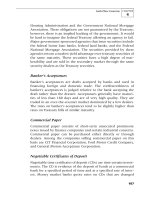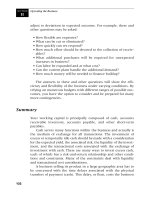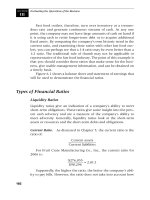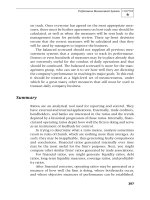Accounting and Finance for Your Small Business doc
Bạn đang xem bản rút gọn của tài liệu. Xem và tải ngay bản đầy đủ của tài liệu tại đây (1.76 MB, 315 trang )
Accounting and
Finance for Your
Small Business
Second Edition
STEVEN M. BRAGG AND
E. JAMES BURTON
John Wiley & Sons, Inc.
ffirs.qxd 11/28/05 1:36 PM Page iii
ffirs.qxd 11/28/05 1:36 PM Page ii
Accounting and
Finance for Your
Small Business
Second Edition
ffirs.qxd 11/28/05 1:36 PM Page i
ffirs.qxd 11/28/05 1:36 PM Page ii
Accounting and
Finance for Your
Small Business
Second Edition
STEVEN M. BRAGG AND
E. JAMES BURTON
John Wiley & Sons, Inc.
ffirs.qxd 11/28/05 1:36 PM Page iii
This book is printed on acid-free paper.ࠗ∞
Copyright © 2006 by PricewaterhouseCoopers. PricewaterhouseCoopers refers to the individual member
firms of the worldwide PricewaterhouseCoopers organization. All rights reserved.
Published by John Wiley & Sons, Inc., Hoboken, New Jersey.
Published simultaneously in Canada.
No part of this publication may be reproduced, stored in a retrieval system, or transmitted in any form
or by any means, electronic, mechanical, photocopying, recording, scanning, or otherwise, except as
permitted under Section 107 or 108 of the 1976 United States Copyright Act, without either the prior
written permission of the Publisher, or authorization through payment of the appropriate per-copy fee
to the Copyright Clearance Center, Inc., 222 Rosewood Drive, Danvers, MA 01923, 978-750-8400, fax
978-646-8600, or on the web at www.copyright.com. Requests to the Publisher for permission should
be addressed to the Permissions Department, John Wiley & Sons, Inc., 111 River Street, Hoboken, NJ
07030, 201-748-6011, fax 201-748-6008, or online at />Limit of Liability/Disclaimer of Warranty: While the publisher and author have used their best efforts
in preparing this book, they make no representations or warranties with respect to the accuracy
or completeness of the contents of this book and specifically disclaim any implied warranties of
merchantability or fitness for a particular purpose. No warranty may be created or extended by sales
representatives or written sales materials. The advice and strategies contained herein may not be
suitable for your situation. You should consult with a professional where appropriate. Neither the
publisher nor author shall be liable for any loss of profit or any other commercial damages, including
but not limited to special, incidental, consequential, or other damages.
For general information on our other products and services, or technical support, please contact our
Customer Care Department within the United States at 800-762-2974, outside the United States at
317-572-3993 or fax 317-572-4002.
Wiley also publishes its books in a variety of electronic formats. Some content that appears in print may
not be available in electronic books.
For more information about Wiley products, visit our Web site at .
Library of Congress Cataloging-in-Publication Data
Bragg, Steven M. .
Accounting and Finance for your small business / Steven M. Bragg.—2nd ed.
p. cm.
Rev. ed. of: Accounting and Finance for your small business / E. James Burton, Steven M. Bragg. 2001.
Includes index.
ISBN-13: 978-0-471-77156-2(cloth)
ISBN-10: 0-471-77156-2 (cloth)
1. Industrial management—Handbooks, manuals, etc. 2. Business enterprises—Finance—
handbooks, manuals etc. 3. Small Business—Management. 4. New business enterprises—
Management. I. Burton, E. James. Accounting and finance for your small business. II. Title.
HD31.B852 2006
658—dc22
2005056956
Printed in the United States of America
10987654321
ffirs.qxd 12/16/05 10:39 AM Page iv
To the Gove family,
who have run the West Newbury town library for two generations
and who taught the Bragg family to love books
ffirs.qxd 11/28/05 1:36 PM Page v
ffirs.qxd 11/28/05 1:36 PM Page vi
About the Authors
S
teven Bragg, CPA, CMA, CIA, CPIM, has been the chief finan-
cial officer or controller of four companies, as well as a consult-
ing manager at Ernst & Young and auditor at Deloitte & Touche. He
received a Master’s degree in finance from Bentley College, an
MBA from Babson College, and a Bachelor’s degree in Economics
from the University of Maine. He has been the two-time presi-
dent of the Colorado Mountain Club, is an avid alpine skier and
mountain biker, and is a certified master diver. Mr. Bragg resides in
Centennial, Colorado. He has published the following books through
John Wiley & Sons:
Accounting and Finance for Your Small Business
Accounting Best Practices
Accounting Reference Desktop
Billing and Collections Best Practices
Business Ratios and Formulas
Controller’s Guide to Costing
Controller’s Guide to Planning and Controlling Operations
Controller’s Guide: Roles and Responsibilities for the New Controller
Controllership
Cost Accounting
Design and Maintenance of Accounting Manuals
Essentials of Payroll
vii
ffirs.qxd 11/28/05 1:36 PM Page vii
About the Authors
Fast Close
Financial Analysis
GAAP Guide
GAAP Implementation Guide
Inventory Accounting
Inventory Best Practices
Just-in-Time Accounting
Managing Explosive Corporate Growth
Outsourcing
Payroll Accounting
Payroll Best Practices
Sales and Operations for Your Small Business
The Controller’s Function
The New CFO Financial Leadership Manual
The Ultimate Accountants’ Reference
Also:
Advanced Accounting Systems (Institute of Internal Auditors)
Run the Rockies (CMC Press)
Subscribe to Steve’s free best practices newsletter at
www.stevebragg.com
E. James Burton, Ph.D., CPA, CFE, is dean of the College of
Business and a full professor of accounting at Middle Tennessee
State University. He has founded, owned, managed, and sold a
number of businesses in a variety of areas from service to manufac-
turing. He received a Bachelor of Arts degree from MacMurray
College in economics/business, a Master of Business Administration
degree from Murray State University in management, and a Ph.D.
in accountancy from the University of Illinois at Urbana-Champaign.
In addition to over 50 journal articles, he has written Total Business
Planning: A Step-by-Step Guide with Forms that has continued through
three editions and translation into Norwegian. He resides in
Murfreesboro, Tennessee.
viii
ffirs.qxd 11/28/05 1:36 PM Page viii
Contents
Preface xiii
Section I Preparing to Operate the Business 1
Chapter 1 Budgeting for Operations 3
Definition or Purpose of an Operating Budget 3
Signs of Budget Ineffectiveness 4
Improvements to the Budgeting System 6
Responsibility Accounting 9
Budget Tracking and Maintenance 21
The System of Interlocking Budgets 25
Need for Budget Updating 35
Summary 36
Chapter 2 Investing in Long-Term Assets
and Capital Budgeting 39
Definitions 40
Overview and Use of Capital Budgeting 41
Life Cycles 42
Capital Budgeting Sequence 43
Producing Numbers to Get Dollars, the Use of Forms, and the
Capital Budgeting Model 48
Miscellaneous Considerations 65
Product Discontinuance 66
Bailout 68
ix
ftoc.qxd 11/28/05 1:37 PM Page ix
Contents
Summary 69
Appendix: Examples and Comparison of Calculations 70
Chapter 3 Basic Control Systems 77
The Need for Control Systems 77
Types of Fraud 79
Key Controls 81
When to Eliminate Controls 97
Summary 99
Section II Operating the Business 101
Chapter 4 Cash Flow Concerns 103
Cash 103
What to Do with Excess Cash 105
Cash Flows 108
Introduction to Cash Flow Budgets 112
Indications of Cash Flow Problems 112
Managing Cash 113
Preparation of the Cash Budget 126
Disbursements 127
Net Cash Flow and Cash Balances 130
Exceptions to Expected Cash Flows 131
Summary 132
Appendix: Cash Flow Example 133
Chapter 5 Financing 143
New Businesses 143
Zero Working Capital and Zero Fixed Assets 144
Types of Financing 148
Private Placement of Stock 157
Swapping Stock for Expenses 158
Stock Warrants 159
Stock Subscriptions 159
How to Obtain a Bank Loan 160
Sources of Debt Financing 167
Types of Loan Arrangements 168
Restrictions on Loans 171
Conditions That a Borrower Should Seek 173
Summary 175
x
ftoc.qxd 11/28/05 1:37 PM Page x
Section III Evaluating the Operations of the Business 177
Chapter 6 Performance Measurement Systems 179
Financial Ratios 180
Types of Financial Ratios 182
Using Performance Measurements for Predictions 193
Operating Ratios 196
Other Ratios 202
The Balanced Scorecard 204
Summary 207
Chapter 7 Financial Analysis 209
Risk Analysis 209
Capacity Utilization 215
Breakeven Analysis 222
Summary 229
Chapter 8 Taxes and Risk Management 231
Controlling Tax Liabilities 232
Risk Management 237
Insurance 245
Types of Insurance Companies 249
Claims Administration 250
Summary 252
Chapter 9 Reporting 255
Federal Government Requirements 255
State Government Requirements 262
Local Government Requirements 267
Creditors 268
Equity Holders 269
Management Reports 269
Summary 286
Index 289
Contents
xi
ftoc.qxd 11/28/05 1:37 PM Page xi
ftoc.qxd 11/28/05 1:37 PM Page xii
Preface
T
his book has been written for business owners and managers
who want to refine the accounting and financial operations of
their companies. It provides detailed information about how to run
these operations, track cash flows, conduct analyses, analyze key
financial information, create a corporate risk management strategy,
and manage tax liabilities—in short, all of the key accounting and
financial information required to operate a small business.
Chapter 1 reveals the interlocking system of budgets, as well as
how to set up a budgeting procedure and use standard budgeting
formats to ensure that revenues are properly projected and matched
to related costs. This is a very important issue for those cyclical
industries in which expenses may be incurred well in advance of
sales receipts; it is also a highly necessary method for controlling
such key expense areas as payroll and inventory.
Chapter 2 covers the budgeting techniques used for capital
acquisition, such as discounted cash flows and payback analysis.
We also note how to modify the capital budgeting procedure to
account for high-risk expenditures, calculate the cost of capital, and
stratify a set of possible capital acquisitions in terms of which is the
most desirable.
Chapter 3 describes the need for a solid set of controls to ensure
that the business operates in accordance with its budget. We also
note a wide array of basic controls that can be adopted by most
businesses not only to ensure budgetary compliance, but also to
reduce the risk of asset loss.
xiii
fpref.qxd 11/28/05 1:36 PM Page xiii
Preface
Chapter 4 turns to the analysis of cash flows. In it we cover the
creation of cash forecasts, the management of cash, and exceptions
to expected cash flows, which can have a serious impact on actual
cash flows. This is a critical area for the small business, which typi-
cally operates with minimal cash reserves.
Chapter 5 describes the various sources of financing that are
available, including internal cash sources, such as zero working
capital, and external ones, such as debt or equity financing, as
well as a number of variations that are useful in specific circum-
stances. Because loans tend to be the chief form of financing, we
also note how to obtain bank loans and key terms found in loan
agreements.
Chapter 6 notes a large number of financial and operating ratios
that are of considerable use in creating a system of performance
measurement for all areas of a small business. We describe how to
calculate and interpret each of the most common ratios.
Chapter 7 covers key areas of financial analysis that are useful
in a small business, including breakeven analysis, capacity utiliza-
tion, risk analysis, and business cycle forecasting. These funda-
mental tools allow one to fine-tune a company’s operations and
anticipate where problems may arise.
Chapter 8 includes coverage of a number of key areas that few
small business owners want to address but that can impact their
business in a negative manner. These issues include the manage-
ment of tax liabilities and the creation of a risk management system
that includes the selective use of insurance.
Chapter 9 covers the four main areas of reporting that are of
concern to the small business owner: reports to the federal govern-
ment, state government, creditors, and for internal management.
We spend most space on internal management reports, because
these can be used with great effectiveness if properly structured to
reveal the most crucial information about ongoing operations and
financial results.
The most effective way to use this book is as a reference source.
We suggest that you first read the book through once, implement-
ing the concepts section by section; it is not casual reading but
rather a manual, intended for a reading-doing-reading-doing
xiv
fpref.qxd 11/28/05 1:36 PM Page xiv
approach. Then, when you have trouble or concerns in a particular
area, consult the specific chapter addressing that problem to find
solutions.
Best wishes for improving, implementing, and benefiting from
your decisions—and for making lots of money.
STEVEN M. BRAGG
Centennial, Colorado
July 2005
Preface
xv
fpref.qxd 11/28/05 1:36 PM Page xv
fpref.qxd 11/28/05 1:36 PM Page xvi
Section I
Preparing to Operate
the Business
T
he first section of the book covers those tasks that should be
accomplished prior to the start of a business or as ongoing
analysis after it has been founded. It accomplishes this objective in
three chapters.
Chapter 1 covers the budgeting function. The issues addressed
here, such as the format of a budget, its components, and how it
should be compared to actual results, are critical to the overall
management of a business, and should be firmly in place before the
organization is created. The budgeting function must also be regu-
larly monitored and controlled to ensure that actual results do not
stray from the plan.
Chapter 2 covers investments in large-dollar items, which are
known as capital items. It covers the steps to be followed in order
to investigate the need for a capital item, compare it to other capi-
tal requests, and determine what should be purchased. This is a
key factor not only in the beginning of a business, but also in the
renewal of key assets over time, as they gradually wear out and
require replacement.
p01.qxd 11/28/05 1:37 PM Page 1
Preparing to Operate the Business
Chapter 3 describes the basic controls that should be installed,
not only to ensure that the probability of fraud is reduced, but also
to verify that the company is not deviating from its planned course.
The full range of controls are presented, including such areas as
billings, payables, fixed assets, and inventory.
SECTION
I
2
p01.qxd 11/28/05 1:37 PM Page 2
Chapter
1
Budgeting for Operations
O
perating budgets are used for planning, operating, and control
functions. To improve your probability of success, you should
engage in not only long-range but also operational budgeting/plan-
ning. The fulfillment of the planning process requires a complete
set of marketing, product, capital, and financial plans as are de-
scribed in this chapter.
Definition or Purpose of an Operating Budget
An operating budget is a projected and, it is hoped, realistic number
picture of income and cost objectives for a period.
Usually operating budgets are constructed for a year, by months.
Some people construct five-year operating budgets with varying
reporting periods. Such budgets are often constructed monthly for
the first two years, quarterly for the next two years, and annually or
semiannually for the remaining year. However, a one-year budget
that is extended quarterly so that it again projects a full year is prob-
ably adequate for most uses.
As with any plan, the ensuing actual performance can be com-
pared with the operating budget to detect “off-target” perfor-
mances and to direct attention to troubled areas. In this way, the
operating budget serves both as a planning tool and a control
device. All functions of the business should be included when
structuring the operating budget. By including all of the operating
3
p01.qxd 11/28/05 1:37 PM Page 3
Preparing to Operate the Business
costs, more performance measures and controls are possible. The
costs incurred to increase the level of preparation detail will relate
favorably to realization of cost savings through better control.
Since measurements of performance may be devised according
to an operating budget, there is a natural tendency for people to
“adjust” the budget process. The potential consequences should be
considered: Sales managers may make overly optimistic assess-
ments of the market, thus reducing the reliability of the cash allo-
cations and expenses anticipated for that level of production and
sales. Some manufacturing managers may “pad” a budget to build
in a safety margin or premium. In a tight market or competitive
sales conditions, this pad could make a product look less attractive
than competing products. The concern should be to make the bud-
get as realistic and accurate as possible because a reasonable budget
based on a reasonable plan encourages reasonable performance.
Signs of Budget Ineffectiveness
Some signs that the budget or budget process is less than optimally
effective are:
• Management or supervisory inattention to the budget. Since a budget is,
or can be used as, a measurement tool, accountability and review
are necessary for control. Without review, there can be little cor-
rective action, and thus there is a loss of control. If management
is not using the budget as a control tool, determine whether the
problem is with the budget or with the management.
• A lack of complete participation by all levels of management within the
firm. Budgets dictated from upper management without input
from the accountable people may have negative effects on the
psychology of the employees and lower management. An atti-
tude of “It’s their budget, let’s see them make it!” may develop.
• Uncorrected large variances between planned performance and budget
objectives. Large budget variances may indicate one of several
weaknesses:
• Poor estimates
SECTION
I
4
p01.qxd 11/28/05 1:37 PM Page 4
• Poor feedback and lack of timely, corrective action
• Ineffective management policies concerning budget mainte-
nance
• Lack of participation in the operation of the business by those who
actively prepare the budgets. Without a working knowledge of the
dynamics of the operations of the business, it is difficult to
maintain a working knowledge of current operational status.
The amount or frequency of contact with operating depart-
ments is usually directly related to the stability of processes. The
greater the variability in the operations of the business, the
more frequently those who prepare the budget should observe
and experience the operating environment.
• Supervisors or first-line managers do not know how their budgets were
determined or what is contained within their budgets. In such cases,
department managers do not know how performance is being
evaluated, how well they are performing to expectations, where
they may be doing well, and where they are experiencing un-
planned difficulties.
Budgets of all types are good planning tools and can also serve
a very valuable control function. In order to be used for control,
these systems must supplement the budget process:
• Feedback loop. Creating the budget itself does not cause programs
to be installed to implement the budget. A feedback loop is nec-
essary to direct attention to areas where difficulties may be
encountered in meeting the business plan. Periodic budget
reports should generate feedback on performance against bud-
get. These reports should trigger action. If the budget and
related performance against budget reports do not flag attention
to problem areas, you are missing the opportunity for needed
improvements.
• Feedback frequency. The feedback loop requires continuous mea-
surement of performance to budget estimates. For feedback to
work properly, it should be regular, expected, and consistently
reported. Comparisons are most effective when they are done
regularly, consistently, and timely. Trend analysis of budget
Budgeting for Operations
CHAPTER
1
5
p01.qxd 11/28/05 1:37 PM Page 5
Preparing to Operate the Business
performance is a good early warning device. Of course, benefits
of the budget reporting process must outweigh the costs.
However, the ongoing evaluation process is one of the places
where you should realize substantial savings.
Improvements to the Budgeting System
Some of the budgeting problems outlined in the last section can be
eliminated or mitigated by implementing a sound budgeting proce-
dure that is closely followed by the management team throughout
the year. In this section we discuss a simple budgeting procedure
that is useful for ensuring that the annual budget is constructed
using a sufficient amount of time, and in the correct order. Later we
also note the monthly schedule to be followed to ensure that the
management team reviews the comparison of budget to actual
results. However, these are strictly procedural matters; the man-
agement team still must be committed to following the dictates of
the budget, which is largely up to the senior management team to
enforce.
The budget procedure that follows is a guideline for the sequen-
tial steps a company should take to ensure that all components of
the budget are completed in the correct order and reviewed by
those people who will be responsible for budget results. The dates
noted in the procedure are based on the assumption that a com-
pany is on a calendar year-end; for those companies with a differ-
ent year-end, just shift the dates to match it.
1. Expense update. As of mid-November, issue to each department
a listing of its expenses that are annualized based on actual
expenses through October of the current year. The listing should
include the personnel in each department and their current
pay levels. Request a return date of 10 days in the future for
this information, which should include estimated changes in
expenses.
2. Revenue update. As of mid-November, issue to the sales manager
a listing of revenue by month by business unit, through October
SECTION
I
6
p01.qxd 11/28/05 1:37 PM Page 6









